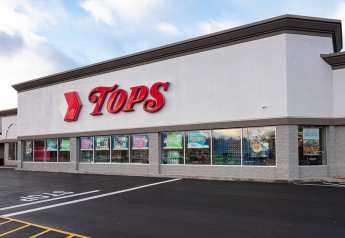COVID-19 cases mount as summer harvesting heats up

Employer and worker advocate groups disagree over solutions as COVID-19 outbreaks escalate at farms and packinghouses while summer harvests kick into high gear — when more H-2A guest agricultural workers arrive in the U.S. and seasonal migrant workers move from one state to the next.
Some farmworker groups are skeptical that recent government health and safety guidelines will be enough to curtail the spread, and are unsure what the effect will be on the fresh fruit and vegetable industry.
Cramped housing and transportation remain trouble areas that employers can’t always control, despite implementing best practices of social distancing, cleaning and sanitizing based on the federal, state and local guidance available.
“Farmworkers’ low wages often forces them into crowded housing where it is difficult to practice social distancing, placing the workers and their children at great risk,” Bruce Goldstein, president of Farmworker Justice, said in an e-mail.
“Access to testing and health care is limited due to geographic isolation and lack of health insurance. Farmworkers are least able to absorb the extra costs imposed by the pandemic.”
Workers
The problems depend on the type of worker as well.
“Worker-advocate groups have opposed H-2A programs, but I’d say it gives employers more ability to manage the risks,” said Craig Regelbrugge, AmericanHort senior vice president of advocacy and research.
The H-2A program’s requirement for employer-provided housing and transportation means employers can better ensure guidelines are followed off the clock, such as spacing beds farther apart, leaving middle seats in vans empty and sanitizing multiple times a day in those locations.
Some employers have stopped H-2A worker grocery trips by sending a point person to take orders and bring groceries back. But 54% of farm laborers, graders and sorters are U.S. citizens, according to USDA Economic Research Service — workers who might need to arrange and pay for their own transportation and housing, often sharing with other workers and their families.
Most vegetable and fruit farmworkers have the advantage of open-air work in the fields, unlike meat-packing plants, said Michael Marsh, president and CEO of the National Council of Agricultural Employers.
But there are still social distancing challenges with harvesting, sorting, grading and packing, and employers are doing what they can to keep workers healthy because it’s in their interest as well, he said.
“For goodness sakes, farmers have been having to adjust everything they’ve been doing for years in a couple weeks. For the most part, they’ve done a very good job,” Marsh said. “I get frustrated because the biggest outbreaks we’ve had in this country have been in New York City, and I don’t believe there are many commercial farm operations there. There are people living on top of one another and public transportation in a crowded environment.”
The number of employer members on the council’s weekly H-2A labor conference call jumped from about 40 to about 150 since the pandemic began, Marsh said.
“They want to learn about the guidance, like what do you do if you have workers that are here and someone gets sick, how do you isolate them from other workers?” he said.
Testing is still not available at the level employers need it, Marsh said, although the supply of masks has improved since March.
The United Fresh Produce Association lobbied members of Congress to ensure that farmworkers could get more personal protective equipment and education and awareness could be disseminated to employers and employees, Robert Guenther, senior vice president of public policy, said in an e-mail.
“As the growing season continues to ramp up in many places around the country, we will apply what we have learned in the first few months of this crisis and build on those lessons to ensure the safety of our employees,” Guenther said.
Guidance
United Fresh has been collaborating with federal, state, and local governments to build employee safety guidance upon already existing best practices and scientifically valid information.
However, the federal guidance was a long time coming.
The U.S. Department of Labor’s Occupational Safety and Health Administration and the Centers for Disease Control and Prevention issued guidance June 2 — about 2½ months after the pandemic first took hold of the country.
“It’s pretty late in the game. Everybody’s been clamoring for guidance. In the industry, we’ve convened on this, but nobody wants to craft the guidance because of the legal implication if it conflicts with either federal authorities or the state authorities,” Regelbrugge said.
Farmworker advocacy leaders, including Goldstein, say enforceable mandates are needed rather than guidance to ensure compliance.
Regelbrugge thinks guidance is better than mandates because employers need the flexibility to adapt the principles to their own situations.
“Bad actors will get punished in the economic sense, if they get an outbreak,” Regelbrugge said.
In New York, 2,076 agricultural workers caught the new coronavirus by June 12, followed by California with 1,948 infected workers, according to Purdue University. Illinois, Texas, Iowa, Washington and Minnesota all have 1,000 or more infected workers.
The pandemic’s timing coincided with the intense agricultural production and harvesting period on California’s Central Coast, said Christopher Valadez, president of the Grower-Shipper Association of Central California. The state was among the first to issue shelter-in-place orders.
To prevent further spread of the virus, the association created a housing program to help COVID-19 positive or exposed agricultural employees safely isolate, Valadez said in an e-mail.
“The association also partnered with area hospitals to create an in-field education program where a physician or nurse will come onsite to discuss COVID-19, and more importantly, engage in dialogue with employees to address questions and provide education about practices to address risks both at the worksite, as well as at home,” Valadez said.
Having enough skilled labor for harvest season is never a guarantee, but even more tenuous since the outbreaks.
Some growers were concerned closed U.S. borders would prevent H-2A workers from arriving to do the harvesting until the Trump administration made special allowances for these temporary immigrants.
A clear indicator of the scarcity of farm labor is the five-fold increase of H-2A positions requested and approved in 14 years, from more than 48,000 positions certified in 2005 to almost 258,000 in 2019, according to the USDA Economic Research Service.
And often, workers want to show up to the fields too.
Employers can give temperature checks and health screenings before each worker clocks in for the day, but without guaranteed sick pay and help with healthcare costs, workers aren’t always motivated to reveal symptoms to their employers, making it difficult to catch the illness in time before it spreads to others, worker-advocate groups said.
And some local health departments don’t notify companies when an employee receives a positive test result, so the company has to rely on workers to inform them.
“I’m not suggesting that every single employer has been doing what they should, but workers and growers are so mutually dependent. It’s holy hell for a grower and worker if there’s a COVID-19 outbreak at the workplace,” Regelbrugge said.
His organization’s nursery and greenhouse growers, breeders and suppliers are trying to tackle the problem holistically, looking at improving best practices in four areas: restructuring the work itself for better sanitation and social distancing; managing group settings such as staggering lunch breaks and meetings; transportation; and housing.
COVID-19 outbreaks at fresh produce farms and facilities have grown:
- June 11: More than 70% of an unspecified number of watermelon harvesters tested positive for COVID-19 in three northern Florida counties;
- June 9: Agriculture workers comprise more than a third of the postive COVID-19 cases in Monterey County, Calif., where an estimated 45,000 farmworkers live permanently, a population that could swell to 60,000 as summertime guest workers arrive, according to the Los Angeles Times;
- June 1: At least 38 strawberry farmworkers in Tennessee tested positive for the virus;
- May 18: Initial results from 126 tests at the first Doctors Without Borders mobile clinics in Immokalee, Fla., an area with more than 15,000 migrant farmworkers, showed a “high positivity rate indicating ongoing community transmission,” according to the organization’s news release;
- Mid-May: Six fruit companies held worker strikes starting mid-May over COVID-19 safety protections and pay, as confirmed cases among farm and fruit-packing workers grew to more than 500 in Yakima Valley, Wash., prompting Gov. Jay Inslee to issue requirements of free personal protective equipment requirements and other safety measures by June 3, according to company leaders and the Seattle Times;
- May 13: 46 cases of COVID-19 were reported at four farms in North Carolina, nine of which were at a strawberry farm, according to a report by WXII NBC Channel 12;
- May 13: More than 35 employees tested positive for the coronavirus at a Ventura County, Calif., avocado and other fruit, according to a report from ABC Channel 12 KCOY;
- May 11 and 19: 109 migrant fieldworkers at two southern New Jersey produce farms, according to reports by NJ Spotlight, based in Montclair, N.J.;
- May 8: 35 workers contracted the virus, confirmed leaders from a fresh-produce processing plant in Kenosha, Wis., to the Milwaukee Journal Sentinel;
- May 7: At least 125 workers at a strawberry and tomato greenhouse in central New York tested positive for the coronavirus, the company confirmed; and
- April 22: 100 COVID-19 cases were linked to a Rhode Island produce-processing plant, according to a report by WJAR NBC Channel 10.
Related news:
Employers face outbreaks, protests, safety hurdles amid COVID-19







